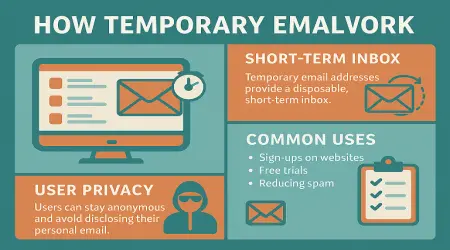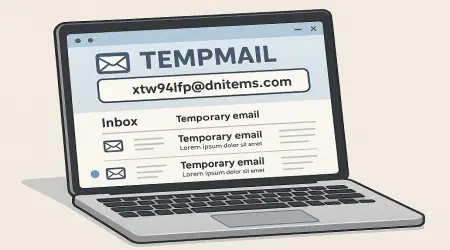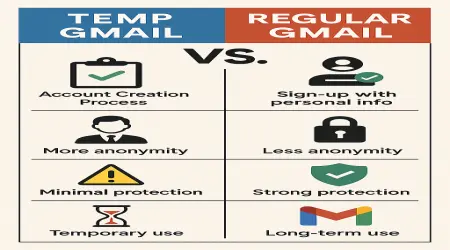

Why Do People Use Temp Mail? 15 Powerful Reasons Explained
Introduction to Temp Mail
In the digital age, our inboxes are constantly flooded with newsletters, marketing pitches, and spam. Countless individuals are using temporary email addresses - temp mail - to protect their privacy and facilitate their online interactions. Why do people use temporary emails anyway? There are many reasons beyond avoiding spam.
What is Temp Mail?
Temp Mail is a temporary email service that will create an inbox for a short period of time. Unlike Gmail, Yahoo, or Outlook, Temp Mail does not accept any permanent accounts. After that, it disappears without leaving any trace.
How Does Temp Mail Work?
Temp Mail randomly generates an email address that you can start using immediately. Emails arrive directly on the service's website or equivalent app. Most of these services store incoming messages for a few hours to a few days, then automatically delete them.
Top Reasons Why People Use Temp Mail
1. Protecting Privacy Online
When signing up for new websites, many people prefer not to share their real email. Temp mail protects personal information from being exposed.
2. Avoiding Spam and Junk Mail
A principal reason people choose temporary mail is to keep their primary inbox clear of unsolicited promotions and spam.
3. Signing Up for Free Trials Safely
Multiple streaming platforms, applications, and web tools generally demand users to verify their email accounts. Using temporary email addresses allows you to register for free trials free from future spam.
4. Preventing Data Breaches
If a webpage is hacked, your actual e-mail may wind up on the dark web. Temp mail protects you from this.
5. Quick and Easy Account Verification
Using temp mail lets you speed through the verification process for apps, downloads, or forums without resorting to your primary email address.
6. Using Temp Mail for Social Media
Some individuals set up temporary email addresses to establish auxiliary social-media profiles intended for testing purposes or to maintain anonymity.
7. Protecting Main Email From Hackers
Hackers frequently look to exploit authentic emails. Employing a temporary inbox enforces an extra level of protection.
8. Anonymous Online Shopping
Many individuals choose to use temporary email addresses when buying on unfamiliar websites so as to thwart spam and safeguard their personal information.
9. Reducing Marketing Emails
Retails love sending all the things deals. Temp mail keeps marketing emails from ever even hitting your inbox.
10. Temporary Registrations on Websites
Especially ideal for one-off use—forums, blogs, and surveys that demand registration.
11. Safe Use on Public Wi-Fi
Employing a temporary email service lessens the risk of disclosing personal email credentials while on public Wi-Fi.
12. Protecting Kids and Teenagers
At times, parents set up temporary email addresses to register their children for games in order to avoid spam and potentially dangerous communications.
13. Business Use Cases of Temp Mail
Marketers and developers frequently make use of temp mail accounts for testing campaigns, software, and demo sign-ups.
14. Digital Nomads and Remote Workers
When they travel and conduct work from anywhere, remote workers rely on temp mail addresses for the convenience of flexibility, free from the clutter of traditional inboxes.
15. Eco-Friendly Digital Hygiene
Reducing spam lowers the amount of excess email on servers, thereby lessening digital pollution.
Pros and Cons of Using Temp Mail
Advantages of Temp Mail
- Protects privacy
- Free of charge and exceptionally easy to use
- Reduces spam
- Art
Limitations of Temp Mail
- Not for banking or high security accounts.
- E-mails are deleted quickly
- Some services prevent temp mail adresse.
FAQs About Temp Mail
Q1: is temp mail safe to use?
Yes, it can be safely used for casual purposes, but do not use it for any sensitive accounts.
Q2: May I use temp mail for banking or government services?
No, temp mail should not be used for critical services.
Q3: How long does a temp mail stand active?
The duration a given temp mail account is active can vary from 10 minutes to 48 hours, depending on the provider.
Q4: Is temp mail lawful?
Yes, it’s legal to use, however, any misuse for fraudulent purposes is illegal.
Q5: Is it possible to track temp mail?
Because most temp mail services ask for no personal information, they are difficult to track.
Q6: Is temp mail offered free of charge?
Indeed, the majority of providers supply free temporary email addresses.
Conclusion
So, why are people encouraged to use temp email accounts? In short, it comes down to privacy, security, and convenience. Temp email address searches for spam evasion, data protection, or free-trial registration make it one of the most powerful digital tools of the 2025 era.




